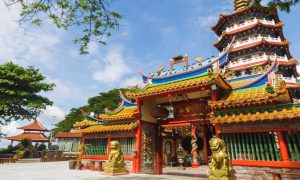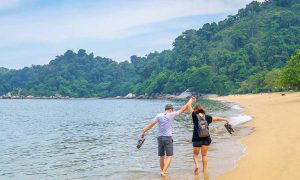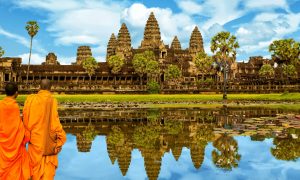This post was written by Pat Fama
Malaysia is unique in its rich variety ethnicities, cultures, and customs that have come to define the country after thousands of years migrations. Pat Fama takes a look at the various groups and what persuaded them to make Malaysia their home.
Malaysia is one of the most racially and culturally diverse places on Earth, as quickly becomes evident to any visitor to the country. The diversity can be seen in the huge variety of food, in the mix of places of worship, in the way people dress, the languages they speak, and of course, in the way people look. And yet all these people are Malaysians, descendants of the wave upon wave of settlers who have come to this rainbow nation looking for a better life.
Orang Asli
It’s believed that the first anatomically modern humans arrived in what is now West Malaysia between 40,000 and 50,000 years ago. The Negrito people, of whom only a few thousand remain today, are the direct descendants of these pioneers. Together with much later waves of settlers, known as the Senoi and the Proto-Malays, they collectively form the Orang Asli, the indigenous peoples of West Malaysia. As nomadic hunter-gatherers, the abundance of fauna and flora must have played a big part in encouraging them to establish permanent roots. Today, there are less than 200,000 Orang Asli remaining, their ancient cultures under serious threat of dying out.
Indigenous Peoples Of East Malaysia
There are dozens of different peoples who are indigenous to Sabah, Sarawak, and Labuan. The largest groups include the Iban, Bidayuh, Melanau, Kadazan-Dusun, Bajau, and Murut. Why, when, and how all these peoples came to move to the Malaysian part of the island of Borneo is not known for sure. Many of them, as hunter-gatherers, must have been drawn by the land’s rich bounty, while others have built a life which relies wholly on the sea. Although much more numerous than the Orang Asli, this group share problems common to indigenous peoples around the world, principally the loss of ancestral land, religious conversion, and cultural assimilation.
Malays
The ancestors of modern Malays started moving to what is now Malaysia as early as 2,500 years ago. They came for a mixture of reasons, from farming land to trade. While Malays are not the indigenous people of Malaysia, they have long been the largest single ethnic group, and today comprise more than half the total population. Over the centuries, Malays have intermarried with Orang Asli and other indigenous peoples, as well as with Indians, Chinese, Arabs, Thais, and the successive waves of migrants from Sumatra, Java, and Sulawesi. For well over 1,500 years, Malay culture was heavily Indianised, but since the 1400s, it has become synonymous with Islam.
Indians
Traders from the Indian subcontinent have been coming to what is now Malaysia for at least two thousand years. With them came language (Sanskrit), customs, and religions (Hinduism and Buddhism), and this culture dominated the Malaysian peninsula for some 1,500 years. How many of these traders settled long-term is difficult to say, but their cultural influence survives to this day. Roughly seven per cent of today’s Malaysian citizens are ethnic Indians, most of whose ancestors arrived during British colonial times. Some came as merchants, others as civil servants, police officers, or railway workers, but the largest single group were indentured labourers, brought in to work on the rubber and tea plantations.
Chinese
Explorers, traders, and emissaries travelled to Malaysia for many centuries before serious migration began. The first boost came from European colonialism, which drew in Chinese settlers from the 16th century onwards. The biggest wave though, during the mid- to late-19th century, was prompted by the surge in demand for tin. Chinese men came in their thousands to work in the tin mines. For most of these pioneers, the eventual aim was to return to China, preferably as rich men, but over the decades many married Malay women or sent to China for wives, and the new land became home. Today, roughly a quarter of all Malaysian citizens are ethnically Chinese.
Indonesians
For thousands of years before the first European colonials arrived, this region was characterised by an ebb and flow of people, culture, language, and religion. Successive waves of settlers came to this land from the Indonesian islands of Java, Sumatra, and Sulawesi. They were drawn by a variety of factors, including trade, land, raw materials, and military rivalry. Independence from colonial rule has not stopped the flow of Indonesians to Malaysia. Indeed, there are hundreds of thousands of economic migrants here today. Unlike their predecessors, they have resisted assimilation into the Malay culture, despite being fellow Muslims and speaking much the same language.
Europeans
Both the ancient Greeks and the Romans knew about this part of the world, but it is unlikely there was direct contact before the European age of exploration. First the Portuguese, then the Dutch, and finally the British established colonial settlements in this country, and these nations were drawn principally by trade, but other factors were at play too; rivalry with other European powers, and Christian evangelism. Reminders of all three colonial powers remain in terms of culture, religion, language, and the built environment. Although very few colonials remained after independence, many of their predecessors married locals, and descendants of these unions still live here.
Mixed Race
Malaysia is not just ethnically diverse, it is ethnically mixed, too. In other words, a huge amount of intermarriage has gone on over the years. Some of these unions produced unique hybrid cultures, such as Baba Nyonya (Chinese men and Malay women), Kristang (a mix of various European and Asian peoples), and Chitty (Indian and Malay). More general mixes, such as Chindian (Indians and Chinese) and Eurasian (European and Asian), are also common.
In the end, the majority of Malaysians, whether they see themselves as Malay, Chinese, or Indian, have some mixed heritage. Their ancestors came here from vastly different places, drawn by a variety of reasons, from farming land to the spice trade. Between them they shaped a place which is now known as Malaysia, and turned this land into a beguiling melting pot of peoples and cultures.
———————————————————————————————————
Source: Senses of Malaysia Jan-Feb 2013
Read More:
- What is the Islamic Arts Museum Malaysia?
- Malaysian Artist Profile: Yap Chew Yee
- Book Review: An Inordinate Fondness for Beetles
What are your thoughts on this article? Let us know by commenting below.No registration needed.
















